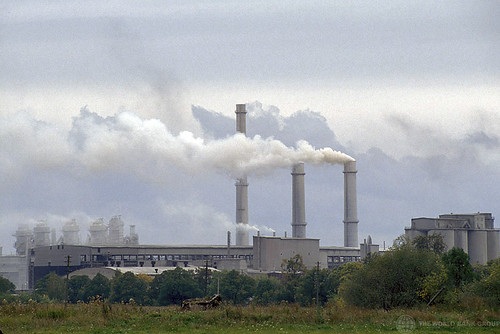世界氣象組織(WMO)發表報告指出,北半球4月的月均大氣二氧化碳濃度史上首次超越400ppm,再次證明燃燒石化燃料和其他人類活動持續導致集熱的溫室氣體增加,讓地球持續暖化。
報告取得加拿大到德國、法國到日本,以及阿拉斯加州巴羅到全球最高的夏威夷毛納洛等各個氣象站的測量數據,以長期測量結果為基礎計算月均濃度,而得到這項結論。
二氧化碳濃度高於南半球 北半球春季達高峰值
全球有130個氣象站在測量二氧化碳濃度。WMO全球大氣觀測網的所有北半球監測站,會在每季最高點回報大氣二氧化碳濃度,也就是北半球春季,成長中的植物尚未開始吸收二氧化碳時。
北半球的春季最高值已經超過400ppm,不過預估全球年均二氧化碳濃度在2015或2016年才會超過這個閾值。
北半球的人為二氧化碳來源比南半球要多,也控制了二氧化碳的季節周期。二氧化碳濃度最低的季節在夏季,因為植物吸收的二氧化碳比其他季節要多。冬季和春季由於生物圈吸收二氧化碳力道不足、有機物質分解以及人為排放的增加,出現二氧化碳濃度高峰。因此最明顯的季節性周期高峰,也出現在最北邊。
春季月均濃度南移 日本、西班牙都超過400ppm
根據加拿大、美國、挪威和芬蘭的全球大氣觀測站接收到的數據,2012年起,北極所有監測站量測到的春季月均二氧化碳濃度,都超過了400ppm。
這個趨勢現在延伸到緯度較低的觀測站了。WMO在維德角、德國、愛爾蘭、日本、西班牙和瑞典的全球觀測站,3月和4月的月均濃度都超過400ppm。
二氧化碳在大氣中停留的時間長達數百年,在海洋中可更久。二氧化碳亦是人類活動排放的溫室氣體中整體威力最強勁的。
2002年至2012年間,輻射驅動力的增加效應,也就是氣候暖化的效應,有85%來自二氧化碳。根據美國海洋大氣管理局(NOAA)的最新資料,1990至2013年間,溫室氣體讓輻射驅動力增加了34%。
For the first time, monthly concentrations of carbon dioxide (CO2) in the atmosphere topped 400 parts per million in April throughout the Northern Hemisphere, the World Meteorological Organization reports.
This threshold is reinforces evidence that the burning of fossil fuels and other human activities are responsible for the continuing increase in heat-trapping greenhouse gases warming the planet said the WMO.
Measurements taken by meterological stations from Canada to Germany, from France to Japan, from Barrow, Alaska to high atop Mauna Loa, Hawaii, contributed to this conclusion.
There are 130 stations worldwide that measure carbon dioxide, and WMO’s monthly mean concentrations are calculated on the basis of continuous measurements.
All the Northern Hemisphere monitoring stations forming the WMO Global Atmosphere Watch network reported record atmospheric CO2 concentrations during the seasonal maximum, which happens early in the Northern Hemisphere spring before growing plants absorb the carbon dioxide.
Spring maximum values in the Northern Hemisphere have already crossed the 400 ppm level, but the global annual average CO2 concentration is not predicted to cross this threshold until 2015 or 2016.
Carbon dioxide remains in the atmosphere for hundreds of years. Its lifespan in the oceans is even longer.
It is the single most important greenhouse gas emitted by human activities. It was responsible for 85 percent of the increase in radiative forcing – the warming effect on our climate – over the decade 2002-2012.
Between 1990 and 2013 there was a 34 percent increase in radiative forcing because of greenhouse gases, according to the latest figures from the U.S. National Oceanic and Atmospheric Administration, NOAA.
Since 2012, all monitoring stations in the Arctic have recorded average monthly CO2 concentrations in spring above 400 ppm, according to data received from Global Atmosphere Watch stations in Canada, the United States, Norway and Finland.
This trend has now spread to observing stations at lower latitudes.
WMO’s global observing stations in Cape Verde, Germany, Ireland, Japan, Spain and Switzerland all reported monthly mean concentrations above 400 ppm in both March and April.
The Northern Hemisphere has more anthropogenic sources of CO2 than the southern hemisphere.
The biosphere also controls the seasonal cycle. The seasonal minimum of CO2 is in summer, when plants take up more of the gas than during other seasons. The winter-spring peak is due to the lack of biospheric uptake, and increased sources related to decomposition of organic material, as well as human-generated emissions.
The most pronounced seasonal cycle is therefore in the far north.








